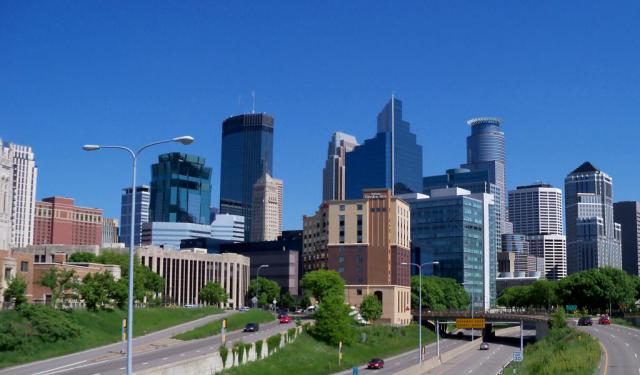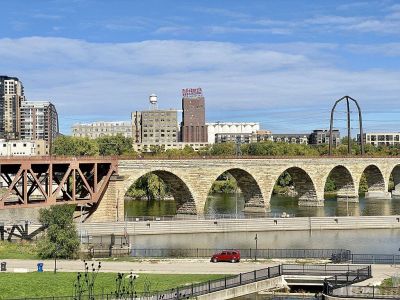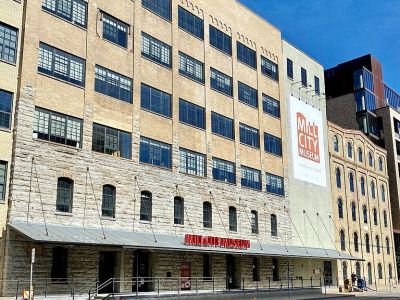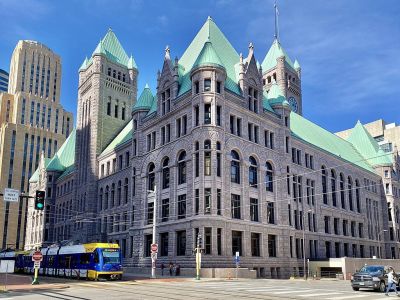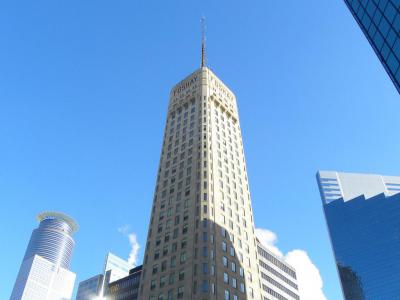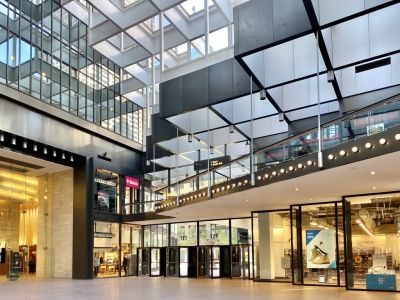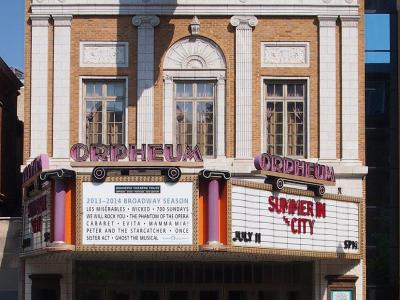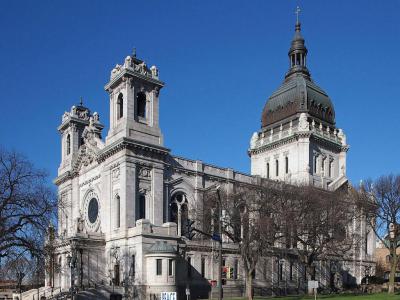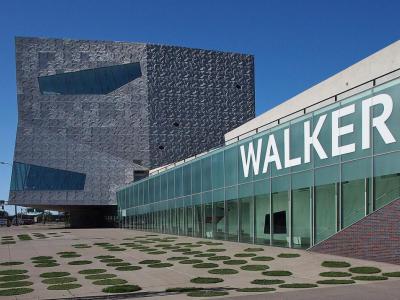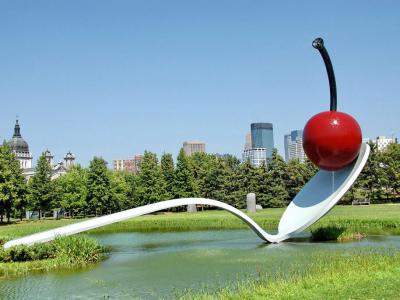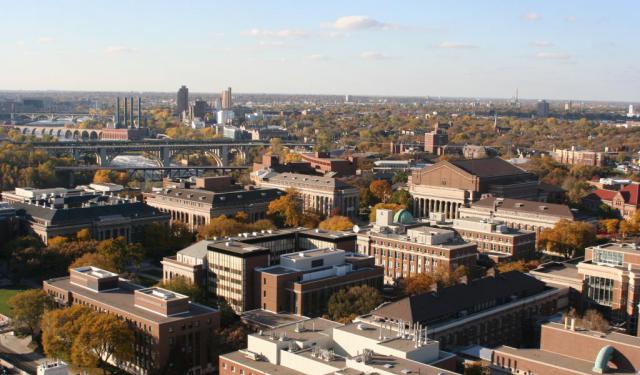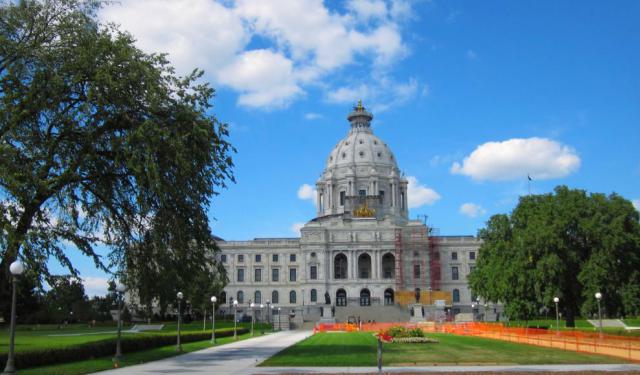Audio Guide: Minneapolis Introduction Walking Tour (Self Guided), Minneapolis
Minneapolis is a major city in Minnesota, straddling the Mississippi River. Together with neighboring Saint Paul, the state capital of Minnesota, it forms the metropolitan area collectively known as the "Twin Cities."
Before European settlement, the site of Minneapolis was inhabited by Dakota people. The settlement was founded along Saint Anthony Falls - the only natural waterfall on the Mississippi River - on land north of Fort Snelling.
The name "Minneapolis" derived from the Dakota word "Mni" meaning water and the Greek word "polis" which means city; thus Minneapolis quite literally translates to the "City of Waters." This or the other moniker, the "City of Lakes," is a fitting tribute to its abundant water resources (thirteen lakes, wetlands, creeks, and waterfalls), which have played a pivotal role in the city's growth providing power for its industrial activity.
Minneapolis's roots are intertwined with the Mississippi River, and the iconic Stone Arch Bridge is a testament to this connection. Originally built as a railroad bridge in the late 19th century, it now serves as a picturesque pedestrian overpass offering breathtaking views of the river and the city's skyline.
A visit to Minneapolis would be incomplete without a stop at the Mill City Museum, a site that pays homage to the city's milling heritage. Housed in the ruins of a historic flour mill, this museum offers a glimpse into the flour industry that once made Minneapolis the "Mill City."
Minneapolis City Hall is another architectural gem worth exploring, with its stunning Richardsonian Romanesque design and a clock tower that rises majestically over the landscape. A few blocks away, the Foshay Tower, reminiscent of the Empire State Building, offers panoramic views of Minneapolis from its observation deck.
For those seeking spiritual solace, the Basilica of Saint Mary is an awe-inspiring place of worship with its monumental architecture and serene ambiance.
Art enthusiasts will find their haven in Minneapolis, with the Walker Art Center and Minneapolis Sculpture Garden. The former houses a remarkable collection of contemporary art, while the latter features iconic sculptures like the famous "Spoonbridge and Cherry."
If you have a taste for arts and architecture, you will find plenty of both in Minneapolis to please your senses. So, don't miss the opportunity to explore this remarkable city and create your own memories. Visit Minneapolis and immerse yourself in its charm and vibrancy on this self-guided walking tour.
Before European settlement, the site of Minneapolis was inhabited by Dakota people. The settlement was founded along Saint Anthony Falls - the only natural waterfall on the Mississippi River - on land north of Fort Snelling.
The name "Minneapolis" derived from the Dakota word "Mni" meaning water and the Greek word "polis" which means city; thus Minneapolis quite literally translates to the "City of Waters." This or the other moniker, the "City of Lakes," is a fitting tribute to its abundant water resources (thirteen lakes, wetlands, creeks, and waterfalls), which have played a pivotal role in the city's growth providing power for its industrial activity.
Minneapolis's roots are intertwined with the Mississippi River, and the iconic Stone Arch Bridge is a testament to this connection. Originally built as a railroad bridge in the late 19th century, it now serves as a picturesque pedestrian overpass offering breathtaking views of the river and the city's skyline.
A visit to Minneapolis would be incomplete without a stop at the Mill City Museum, a site that pays homage to the city's milling heritage. Housed in the ruins of a historic flour mill, this museum offers a glimpse into the flour industry that once made Minneapolis the "Mill City."
Minneapolis City Hall is another architectural gem worth exploring, with its stunning Richardsonian Romanesque design and a clock tower that rises majestically over the landscape. A few blocks away, the Foshay Tower, reminiscent of the Empire State Building, offers panoramic views of Minneapolis from its observation deck.
For those seeking spiritual solace, the Basilica of Saint Mary is an awe-inspiring place of worship with its monumental architecture and serene ambiance.
Art enthusiasts will find their haven in Minneapolis, with the Walker Art Center and Minneapolis Sculpture Garden. The former houses a remarkable collection of contemporary art, while the latter features iconic sculptures like the famous "Spoonbridge and Cherry."
If you have a taste for arts and architecture, you will find plenty of both in Minneapolis to please your senses. So, don't miss the opportunity to explore this remarkable city and create your own memories. Visit Minneapolis and immerse yourself in its charm and vibrancy on this self-guided walking tour.
How it works: Download the app "GPSmyCity: Walks in 1K+ Cities" from Apple App Store or Google Play Store to your mobile phone or tablet. The app turns your mobile device into a personal tour guide and its built-in GPS navigation functions guide you from one tour stop to next. The app works offline, so no data plan is needed when traveling abroad.
Minneapolis Introduction Walking Tour Map
Guide Name: Minneapolis Introduction Walking Tour
Guide Location: USA » Minneapolis (See other walking tours in Minneapolis)
Guide Type: Self-guided Walking Tour (Sightseeing)
# of Attractions: 9
Tour Duration: 2 Hour(s)
Travel Distance: 4.2 Km or 2.6 Miles
Author: ChristineS
Sight(s) Featured in This Guide:
Guide Location: USA » Minneapolis (See other walking tours in Minneapolis)
Guide Type: Self-guided Walking Tour (Sightseeing)
# of Attractions: 9
Tour Duration: 2 Hour(s)
Travel Distance: 4.2 Km or 2.6 Miles
Author: ChristineS
Sight(s) Featured in This Guide:
- Stone Arch Bridge
- Mill City Museum
- Minneapolis City Hall
- Foshay Tower
- Nicollet
- Orpheum Theatre
- Basilica of St. Mary
- Walker Art Center
- Minneapolis Sculpture Garden
1) Stone Arch Bridge (must see)
The Stone Arch Bridge in Minneapolis is a striking symbol of the city’s industrial glory days. Stretching across the Mississippi River at Saint Anthony Falls, it serves as a gateway to some of the city’s most picturesque views. Not only is it the only stone-arched bridge along the entire Mississippi River, but it also claims the title of the second-oldest bridge on the waterway-only losing to Saint Louis’s Eads Bridge in a historical game of “who’s older”.
Built in 1883 by railroad tycoon James J. Hill to shuttle passenger trains to a station a mile west, the bridge was initially nicknamed “Hill’s Folly”. Yet once its value in connecting passengers became clear, those skeptics had to eat their words (and maybe some humble pie). Engineer Charles C. Smith designed its graceful arches to flow with the nearby falls and surrounding terrain, using local granite from Sauk Rapids and magnesium limestone from Mankato and Iowa for the upper sections.
In its long lifetime, the Stone Arch Bridge has worn many hats. It got a wider girth in 1925 to support larger railcars, only to trade the rail life for a pedestrian and cyclist paradise in 1994. By 1971, it made the National Register of Historic Places, and in 1974, it nabbed a National Historic Civil Engineering Landmark title. Fast forward to 2005, and the bridge received a glow-up with indirect lighting.
Today, the bridge moonlights as a festival hotspot, hosting Independence Day fireworks and Minneapolis Aquatennial displays that draw oohs and ahhs from the crowds. It’s also a year-round runway for skyline selfies, views of the historic Pillsbury “A” Mill, the Mill City Museum, and more. And with the lively Main Street restaurants and the Guthrie Theater just steps away, the Stone Arch Bridge is less a relic of the past and more a vibrant link between history and modern city life.
Built in 1883 by railroad tycoon James J. Hill to shuttle passenger trains to a station a mile west, the bridge was initially nicknamed “Hill’s Folly”. Yet once its value in connecting passengers became clear, those skeptics had to eat their words (and maybe some humble pie). Engineer Charles C. Smith designed its graceful arches to flow with the nearby falls and surrounding terrain, using local granite from Sauk Rapids and magnesium limestone from Mankato and Iowa for the upper sections.
In its long lifetime, the Stone Arch Bridge has worn many hats. It got a wider girth in 1925 to support larger railcars, only to trade the rail life for a pedestrian and cyclist paradise in 1994. By 1971, it made the National Register of Historic Places, and in 1974, it nabbed a National Historic Civil Engineering Landmark title. Fast forward to 2005, and the bridge received a glow-up with indirect lighting.
Today, the bridge moonlights as a festival hotspot, hosting Independence Day fireworks and Minneapolis Aquatennial displays that draw oohs and ahhs from the crowds. It’s also a year-round runway for skyline selfies, views of the historic Pillsbury “A” Mill, the Mill City Museum, and more. And with the lively Main Street restaurants and the Guthrie Theater just steps away, the Stone Arch Bridge is less a relic of the past and more a vibrant link between history and modern city life.
2) Mill City Museum (must see)
Opened in 2003, Mill City Museum rose from the ashes of the Washburn “A” Mill-literally. Once the largest and most cutting-edge flour mill on the planet back in 1880, this grand mill sparked a milling revolution that gave Minneapolis bragging rights as the flour milling capital of the world from 1880 to 1930. Talk about rolling in the dough.
By 1965, the mill had run its course and shut down, and a fire in 1991 left it looking like something out of a post-apocalyptic movie. But rather than letting it crumble, Minneapolis decided to turn lemons into lemonade-or, rather, wheat into, well, an award-winning museum.
The Minnesota Historical Society stepped in and called on architect Thomas Meyer to design a building that respected the past while welcoming the future. The result? A blend of preserved flour bins, milling machinery, and a rail corridor-all complemented with sleek modern touches, including a glass curtain wall etched with historic mill diagrams and multiple entry points that effortlessly link downtown with the Mississippi riverfront.
It’s not just a pretty face, either. The museum has racked up major design awards and continues to draw visitors into the city’s milling heritage. Inside, you can witness baking demonstrations, nibble on fresh bread, gawk at a model mill explosion, and enjoy amazing views of Saint Anthony Falls and the Stone Arch Bridge from the observation deck. Among other highlights are the Flour Tower exhibit and the much-recommended short film “Minneapolis in 19 Minutes Flat!”
By 1965, the mill had run its course and shut down, and a fire in 1991 left it looking like something out of a post-apocalyptic movie. But rather than letting it crumble, Minneapolis decided to turn lemons into lemonade-or, rather, wheat into, well, an award-winning museum.
The Minnesota Historical Society stepped in and called on architect Thomas Meyer to design a building that respected the past while welcoming the future. The result? A blend of preserved flour bins, milling machinery, and a rail corridor-all complemented with sleek modern touches, including a glass curtain wall etched with historic mill diagrams and multiple entry points that effortlessly link downtown with the Mississippi riverfront.
It’s not just a pretty face, either. The museum has racked up major design awards and continues to draw visitors into the city’s milling heritage. Inside, you can witness baking demonstrations, nibble on fresh bread, gawk at a model mill explosion, and enjoy amazing views of Saint Anthony Falls and the Stone Arch Bridge from the observation deck. Among other highlights are the Flour Tower exhibit and the much-recommended short film “Minneapolis in 19 Minutes Flat!”
3) Minneapolis City Hall
The City Hall and Courthouse, completed over the years 1887 to 1906, occupy a historic site where the first public schoolhouse west of the Mississippi once stood. This isn’t just your average municipal building-thanks to its Richardsonian Romanesque style and a medley of interior design influences, it boasts a charm and majesty that’s hard to come by in today’s glass-and-steel world.
If you’re curious to peek inside, tours are held every third Wednesday at noon. Just meet in the rotunda at the base of the colossal “Father of Waters” statue. This seven-ton marble marvel comes from the famed Carrara quarries, the same stony birthplace of masterpieces by Michelangelo and Leonardo da Vinci.
The building itself is clad in Ortonville granite, with some stones tipping the scales at more than twenty tons. Originally capped by a red terra cotta roof (which didn’t last long before springing leaks), it now flaunts a copper crown-the heaviest of its kind when installed, weighing in at 180,000 pounds. Add a towering clock to the mix-a timepiece that rivals London’s Big Ben-and you’ve got a structure that commands attention from every angle.
Surrounded by stained glass windows and carved Italian marble, the venue includes a stunning vestibule, a majestic five-story rotunda, and even some million-year-old fossils. The City Council Chambers exude stately gravitas, and the first-floor balcony provides a prime perch for taking it all in.
Today, the building’s stately halls and offices are split between city and county tenants. Roughly 60 percent houses City departments, while the County and District Courts call the remaining 40 percent their home.
If you’re curious to peek inside, tours are held every third Wednesday at noon. Just meet in the rotunda at the base of the colossal “Father of Waters” statue. This seven-ton marble marvel comes from the famed Carrara quarries, the same stony birthplace of masterpieces by Michelangelo and Leonardo da Vinci.
The building itself is clad in Ortonville granite, with some stones tipping the scales at more than twenty tons. Originally capped by a red terra cotta roof (which didn’t last long before springing leaks), it now flaunts a copper crown-the heaviest of its kind when installed, weighing in at 180,000 pounds. Add a towering clock to the mix-a timepiece that rivals London’s Big Ben-and you’ve got a structure that commands attention from every angle.
Surrounded by stained glass windows and carved Italian marble, the venue includes a stunning vestibule, a majestic five-story rotunda, and even some million-year-old fossils. The City Council Chambers exude stately gravitas, and the first-floor balcony provides a prime perch for taking it all in.
Today, the building’s stately halls and offices are split between city and county tenants. Roughly 60 percent houses City departments, while the County and District Courts call the remaining 40 percent their home.
4) Foshay Tower
Rising 447 feet over downtown Minneapolis, the Foshay Tower is a one-of-a-kind Art Deco marvel turned luxury hotel. Once the crown jewel of Wilbur Foshay’s short-lived utilities empire, this Washington Monument-inspired skyscraper offers a museum, a rooftop deck with panoramic views, and a rich history of gangsters, tycoons, and rock stars.
Saved from demolition in the 1970s and reborn as a luxury hotel in 2008, the Foshay mixes timeless elegance with modern flair. In the lobby, Italian neon casts a rosy glow over the 1930s grandeur, while high-back leather chairs and towering palms set the scene for the ultimate mingle spot. Guests sip artisan cocktails at a sleek marble bar beneath a cascade of shimmering blue glass beads, proving that history and modern flair go hand in hand.
Manny’s Steakhouse, a Twin Cities dining legend, tempts visitors with James Beard Award-winning steaks, while the Prohibition Bar on the 27th and 28th floors serves up cocktails in a cozy, wood-paneled library with stunning skyline views.
For a laid-back meal, Keys at the Foshay, conveniently located on the ground floor, serves up hearty, family-friendly dishes. This adds to the Foshay Tower’s charm as a unique combination of historic landmark, food lover’s destination, and refined urban retreat.
Saved from demolition in the 1970s and reborn as a luxury hotel in 2008, the Foshay mixes timeless elegance with modern flair. In the lobby, Italian neon casts a rosy glow over the 1930s grandeur, while high-back leather chairs and towering palms set the scene for the ultimate mingle spot. Guests sip artisan cocktails at a sleek marble bar beneath a cascade of shimmering blue glass beads, proving that history and modern flair go hand in hand.
Manny’s Steakhouse, a Twin Cities dining legend, tempts visitors with James Beard Award-winning steaks, while the Prohibition Bar on the 27th and 28th floors serves up cocktails in a cozy, wood-paneled library with stunning skyline views.
For a laid-back meal, Keys at the Foshay, conveniently located on the ground floor, serves up hearty, family-friendly dishes. This adds to the Foshay Tower’s charm as a unique combination of historic landmark, food lover’s destination, and refined urban retreat.
5) Nicollet
The Nicollet (formerly Nicollet Mall) has long been downtown Minneapolis’s go-to hub for shopping and entertainment. With its recent glow-up, it’s become even more inviting for visitors, local workers, and city dwellers. Motor vehicles are limited to buses and taxis, leaving this mile-long pedestrian-friendly stretch to flaunt its sidewalk cafés, art installations, greenery, and a medley of shops.
Look up, and you’ll spot the famed Minneapolis Skyway System-9.5 miles of weatherproof passageways connecting 80 city blocks. This elevated urban maze isn’t just practical; it’s a destination in itself. You can grab a bite, shop, or take a stroll to major venues like Orchestra Hall, Target Center, U.S. Bank Stadium, and more-all without stepping outdoors. Nicollet’s skyway access points include the iconic Crystal Court in the IDS Center (downtown’s tallest building) and the flagship Target store at Nicollet and 9th Street.
On the ground, a string of sidewalk patios beckons you to relax, sip a drink, and watch the world go by-minus the clamor of traffic.
Pro tip: If you’re seeking a warm, cozy skyway spot, head to Come Pho Soup-a French-Vietnamese fusion restaurant that serves steaming pho bowls (including a DIY option) and hearty Banh Mi sandwiches. Craving a sweet treat? Cardigan Donuts, found in both the IDS Tower and City Center, whips up a unique donut flavor each week and offers coffee, tea, yogurt bowls, and even ice cream.
Look up, and you’ll spot the famed Minneapolis Skyway System-9.5 miles of weatherproof passageways connecting 80 city blocks. This elevated urban maze isn’t just practical; it’s a destination in itself. You can grab a bite, shop, or take a stroll to major venues like Orchestra Hall, Target Center, U.S. Bank Stadium, and more-all without stepping outdoors. Nicollet’s skyway access points include the iconic Crystal Court in the IDS Center (downtown’s tallest building) and the flagship Target store at Nicollet and 9th Street.
On the ground, a string of sidewalk patios beckons you to relax, sip a drink, and watch the world go by-minus the clamor of traffic.
Pro tip: If you’re seeking a warm, cozy skyway spot, head to Come Pho Soup-a French-Vietnamese fusion restaurant that serves steaming pho bowls (including a DIY option) and hearty Banh Mi sandwiches. Craving a sweet treat? Cardigan Donuts, found in both the IDS Tower and City Center, whips up a unique donut flavor each week and offers coffee, tea, yogurt bowls, and even ice cream.
6) Orpheum Theatre
The Orpheum is a star in Hennepin Avenue’s lineup of restored historic venues, standing proudly alongside the Pantages, State, and Shubert (now Goodale) theaters. Opened in 1921, this theater was built to dazzle, welcoming 2,600 eager patrons for vaudeville acts and live performances. In true showbiz fashion, it even came outfitted with a dedicated elevator-not for performers or sets, mind you, but for the animal stars of the era’s grand touring productions.
Over the decades, the Orpheum has staged everything from Big Band concerts to Broadway tours. Its design is as grand as its legacy. The lobby, with its long, slender layout, connects a narrow Hennepin Avenue entrance to the set-back auditorium, which sits parallel to Hawthorne Avenue. Inside, you’ll find terra cotta bas relief sculptures in the lobby, a ceiling dome adorned with 30,000 aluminum leaf squares, and plasterwork so ornate it might make a wedding cake jealous. The theater seats 1,500 on the main floor and another 1,100 in the three-level balcony.
Pro tip: Make your Orpheum visit even more legendary by stopping by the nearby Jack Link’s Legend Lounge. It’s a swanky spot for theatergoers, offering specialty cocktails, wine, beer, non-alcoholic options, and protein snacks. The lounge opens 90 minutes before each show, giving you plenty of time to sip and snack before the curtain rises.
Over the decades, the Orpheum has staged everything from Big Band concerts to Broadway tours. Its design is as grand as its legacy. The lobby, with its long, slender layout, connects a narrow Hennepin Avenue entrance to the set-back auditorium, which sits parallel to Hawthorne Avenue. Inside, you’ll find terra cotta bas relief sculptures in the lobby, a ceiling dome adorned with 30,000 aluminum leaf squares, and plasterwork so ornate it might make a wedding cake jealous. The theater seats 1,500 on the main floor and another 1,100 in the three-level balcony.
Pro tip: Make your Orpheum visit even more legendary by stopping by the nearby Jack Link’s Legend Lounge. It’s a swanky spot for theatergoers, offering specialty cocktails, wine, beer, non-alcoholic options, and protein snacks. The lounge opens 90 minutes before each show, giving you plenty of time to sip and snack before the curtain rises.
7) Basilica of St. Mary (must see)
The Basilica of Saint Mary, one of the finest Neoclassical Beaux-Arts creations in the U.S., was quite the million-dollar project. Archbishop John Ireland tapped Emmanuel Louis Masqueray, a French-trained architectural wizard fresh off designing the 1904 Saint Louis World’s Fair, to give the building its flair. Masqueray, a Renaissance and Baroque enthusiast, got to work in 1907. But between World War I stretching resources thin and Masqueray’s untimely passing in 1917, it wasn’t until 1926 that the Basilica reached its full glory. Pope Pius XI later crowned it the first Basilica in North America, and it joined the National Register of Historic Places in 1975.
This architectural wonder is admired for three main reasons: its stellar design and Baroque influence, its role in Minnesota’s religious history, and, of course, its groundbreaking status as the first U.S. basilica. Inside, visitors can marvel at the dazzling stained-glass windows (completed in 1924) and a permanent art collection filled with sculptures and paintings.
But to most Minneapolitans, the Basilica is also home to something a bit less traditional: the Basilica Block Party, the city’s beloved late-summer celebration of alt-rock and community spirit.
This architectural wonder is admired for three main reasons: its stellar design and Baroque influence, its role in Minnesota’s religious history, and, of course, its groundbreaking status as the first U.S. basilica. Inside, visitors can marvel at the dazzling stained-glass windows (completed in 1924) and a permanent art collection filled with sculptures and paintings.
But to most Minneapolitans, the Basilica is also home to something a bit less traditional: the Basilica Block Party, the city’s beloved late-summer celebration of alt-rock and community spirit.
8) Walker Art Center
The Walker Art Center has been a Minneapolis cultural cornerstone since 1940, offering 11 galleries of modern and contemporary art, the Walker Cinema, and the McGuire Theater. Its mix of permanent collections, rotating exhibits, and interdisciplinary programming makes it a must-see for anyone craving a hit of creative inspiration. Between the rooftop terrace, plazas, and sculpture-dotted gardens, you can take in the art or simply kick back and enjoy the ambiance. Plus, the Walker regularly hosts classes, workshops, performances, and screenings, so you’ll never run out of things to do. Bonus? Free gallery admission every Thursday evening and the first Saturday of every month-because who says the best things in life aren’t free?
Pro tip: Treat yourself to a culinary side quest at Cardamom, the Walker’s on-site eatery that’s so much more than “just a museum restaurant”. Helmed by Minneapolis chefs Daniel del Prado and Shawn McKenzie, this Aegean-Mediterranean-inspired spot boasts a menu that’s as artful as the exhibits. Add in sleek modern décor and a wall of glass offering stunning views, and you’ve got a dining experience that’s a masterpiece in its own right.
Pro tip: Treat yourself to a culinary side quest at Cardamom, the Walker’s on-site eatery that’s so much more than “just a museum restaurant”. Helmed by Minneapolis chefs Daniel del Prado and Shawn McKenzie, this Aegean-Mediterranean-inspired spot boasts a menu that’s as artful as the exhibits. Add in sleek modern décor and a wall of glass offering stunning views, and you’ve got a dining experience that’s a masterpiece in its own right.
9) Minneapolis Sculpture Garden (must see)
Directly across the street from the Walker Art Center, the Minneapolis Sculpture Garden claims the title of the world’s largest urban sculpture park. Spanning 11 acres (45,000 square meters), this green oasis once served as a military drill ground, but it now showcases an impressive collection of around 40 modern and contemporary artworks. The most photographed-and perhaps most beloved-piece is undoubtedly Claes Oldenburg and Coosje van Bruggen’s “Spoonbridge and Cherry”, a whimsical, oversized spoon delicately balancing a bright red cherry. There’s also “Hahn/Cock”, a strikingly blue rooster that stands proud, nearly daring visitors to snap its photo against the backdrop of the downtown Minneapolis skyline and the magnificent Basilica of Saint Mary.
Even better, admission to the Sculpture Garden is absolutely free. Come rain, shine, or snow, you can wander the grounds every single day of the year. Beyond the outdoor sculptures, the Garden also offers the delights of the Cowles Conservatory-an indoor sanctuary that features tropical flora, a lush escape from the chilly Minnesota winters, and, of course, art. Inside, you’ll find Frank Gehry’s dazzling “Standing Glass Fish”-proof that art and nature aren’t just neighbors here; they’re inextricably entwined.
Pro tip: When you’re ready to keep the art-inspired stroll going, make your way across the brightly-hued Irene Hixon Whitney Bridge over Hennepin Avenue to Loring Park. Once there, meander through the park’s tree-lined paths while taking in more art and nature. Feeling peckish? Head to Café and Bar Lurcat for a dining experience that’s as refined as it is relaxed.
Even better, admission to the Sculpture Garden is absolutely free. Come rain, shine, or snow, you can wander the grounds every single day of the year. Beyond the outdoor sculptures, the Garden also offers the delights of the Cowles Conservatory-an indoor sanctuary that features tropical flora, a lush escape from the chilly Minnesota winters, and, of course, art. Inside, you’ll find Frank Gehry’s dazzling “Standing Glass Fish”-proof that art and nature aren’t just neighbors here; they’re inextricably entwined.
Pro tip: When you’re ready to keep the art-inspired stroll going, make your way across the brightly-hued Irene Hixon Whitney Bridge over Hennepin Avenue to Loring Park. Once there, meander through the park’s tree-lined paths while taking in more art and nature. Feeling peckish? Head to Café and Bar Lurcat for a dining experience that’s as refined as it is relaxed.
Walking Tours in Minneapolis, Minnesota
Create Your Own Walk in Minneapolis
Creating your own self-guided walk in Minneapolis is easy and fun. Choose the city attractions that you want to see and a walk route map will be created just for you. You can even set your hotel as the start point of the walk.
Historical Churches
The "City of Lakes”, Minneapolis, doesn't pride itself solely on the lakes. In fact, you will be amazed by how many churches, cathedrals, and other places of worship are found throughout the city. These sacred structures have played a significant role in the development of Minneapolis and continue to serve as pillars of faith and community. Let's take a look at some of the most... view more
Tour Duration: 1 Hour(s)
Travel Distance: 2.8 Km or 1.7 Miles
Tour Duration: 1 Hour(s)
Travel Distance: 2.8 Km or 1.7 Miles
University of Minnesota - Minneapolis Campus Walking Tour
Founded in 1851, seven years before Minnesota became a state, the University of Minnesota is one of the largest educational institutions in the United States. The university campus in the “Twin Cities” of Minneapolis and Saint Paul, spread along the bank of the Mississippi River, is a sprawling hub renowned for its rich academic environment and vibrant life.
One of the central gathering... view more
Tour Duration: 2 Hour(s)
Travel Distance: 2.9 Km or 1.8 Miles
One of the central gathering... view more
Tour Duration: 2 Hour(s)
Travel Distance: 2.9 Km or 1.8 Miles
Saint Paul Introduction Walking Tour
Saint Paul is a fantastic example of a city that has grown through a diverse range of cultures. The location near the Mississippi River helped make what would later become the city a significant center of local trade. The Dakota Sioux tribe were among the earliest residents, and European settlement that included French-Canadian fur traders and Catholic missionaries occurred during the 1830s to... view more
Tour Duration: 2 Hour(s)
Travel Distance: 3.4 Km or 2.1 Miles
Tour Duration: 2 Hour(s)
Travel Distance: 3.4 Km or 2.1 Miles
The Most Popular Cities
/ view all
